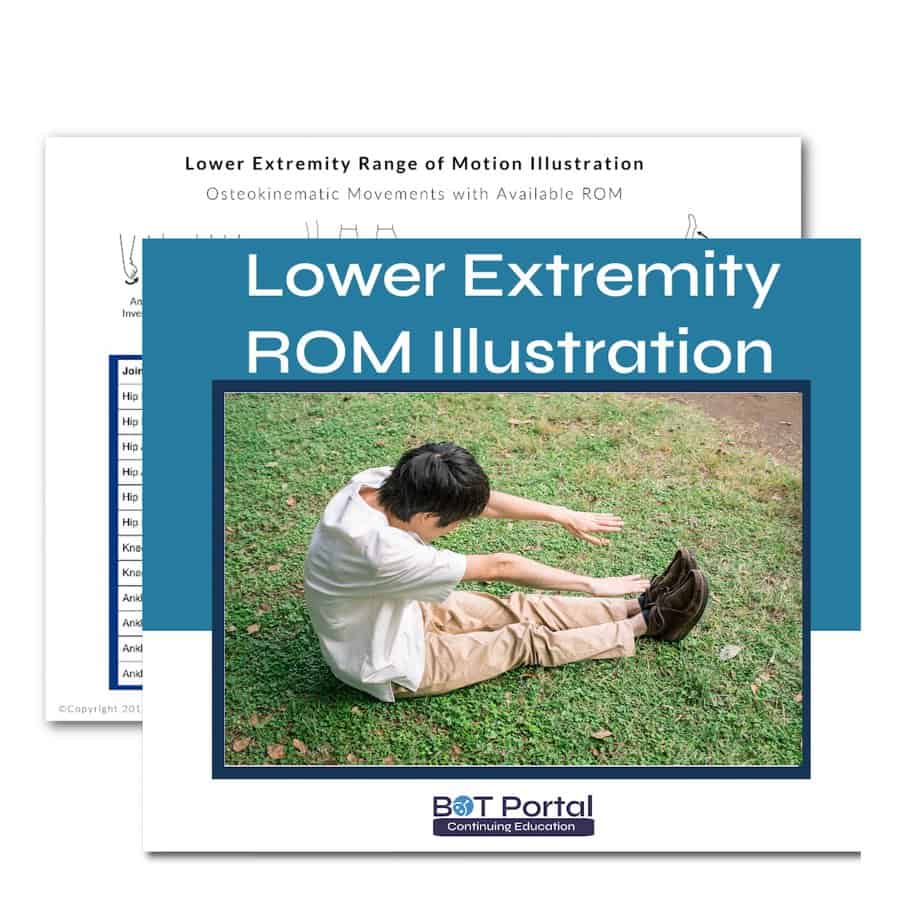Description
Lower Extremity Range of Motion
Lower extremity range of motion (ROM) is a critical focus in occupational therapy (OT) rehabilitation. It involves assessing and improving the flexibility and movement of the hip, knee, and ankle joints. This is essential for activities like walking, climbing stairs, sitting, and standing, which are fundamental for daily living and independence.
Understanding Range of Motion
Range of motion refers to the extent a joint can move in different directions. For the lower extremities, this includes:
- Hip: Movements such as flexion (bending forward), extension (straightening), abduction (moving away from the body), adduction (moving toward the body), and rotation.
- Knee: Flexion (bending) and extension (straightening).
- Ankle: Dorsiflexion (moving the foot upward), plantar flexion (moving the foot downward), inversion (turning the sole inward), and eversion (turning the sole outward).
Importance in Rehabilitation
Improving lower extremity ROM is vital for several reasons:
- Mobility and Independence: Adequate ROM in the lower extremities allows individuals to perform essential activities like walking, sitting, standing, and transitioning between these positions. Without sufficient ROM, these activities can become challenging or impossible.
- Balance and Stability: Proper ROM is crucial for maintaining balance and preventing falls. Limited movement in the hips, knees, or ankles can disrupt stability, increasing the risk of falls and related injuries, especially in older adults or those with certain medical conditions.
- Pain Management: Limited ROM can lead to stiffness and discomfort. Improving flexibility through targeted exercises can help reduce pain and improve overall comfort.
- Preventing Complications: After surgery or injury, limited movement can lead to complications like muscle atrophy (wasting away), joint stiffness, and decreased circulation. Regular ROM exercises help prevent these issues, promoting better recovery and long-term health.
Occupational Therapy Interventions
In OT, therapists use various techniques to improve lower extremity ROM:
- Stretching Exercises: These help increase flexibility and lengthen tight muscles. For example, hamstring stretches can improve hip and knee ROM.
- Strengthening Exercises: Building muscle strength around the joints can support better movement. Therapists might recommend exercises like leg lifts or ankle pumps.
- Manual Therapy: Therapists may use hands-on techniques to gently move the joints through their full range of motion, helping to reduce stiffness and improve flexibility.
- Functional Activities: Incorporating ROM exercises into daily activities can make therapy more practical and engaging. This might involve practicing getting in and out of a chair or walking on different surfaces.
- Adaptive Equipment: Tools like resistance bands or ankle weights can enhance ROM exercises, providing additional support and challenge.
Lower extremity range of motion is a fundamental aspect of OT rehabilitation, crucial for mobility, independence, and overall quality of life. Through targeted exercises and interventions, occupational therapists help individuals regain flexibility, improve function, and lead more active, independent lives.




